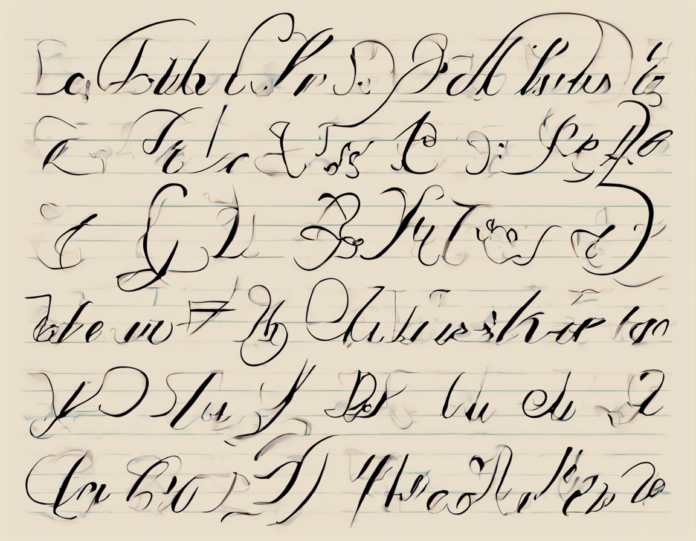Cursive handwriting, once an essential skill taught in schools worldwide, has become somewhat of a lost art in recent years. With the increase in digital communication and typing on keyboards, the emphasis on teaching cursive has diminished. However, mastering cursive handwriting can offer numerous benefits, from improved hand-eye coordination to enhancing creativity and self-expression. In this comprehensive guide, we will delve into the world of cursive handwriting from A to Z, providing you with tips, techniques, and exercises to help you master this beautiful form of writing.
The Importance of Cursive Handwriting
In the age of text messages and emails, the art of cursive handwriting may seem outdated to some. However, numerous studies have shown that there are many benefits to learning cursive, especially at a young age. Here are some reasons why cursive handwriting is still relevant today:
1. Improves Hand-Eye Coordination
- Writing in cursive requires the coordination of hand movements and visual input, which can help improve hand-eye coordination and fine motor skills.
2. Enhances Learning and Memory
- Research has shown that students who take notes in cursive retain information better than those who type notes on a computer. Writing in cursive engages different parts of the brain, leading to better memory retention.
3. Boosts Creativity and Self-Expression
- Cursive handwriting allows for more fluidity and personal style than printing. It can be a form of artistic expression and creativity, enabling individuals to develop their unique writing style.
4. Preserves History and Tradition
- Many historical documents, such as the Declaration of Independence and personal letters from famous figures, were written in cursive. Mastering cursive allows individuals to read and appreciate these historical documents firsthand.
Getting Started with Cursive Writing
If you're ready to embark on your journey to mastering cursive handwriting, here are some tips to help you get started:
1. Understanding the Basics
- Before diving into writing individual letters, familiarize yourself with the basic strokes used in cursive writing, such as upstrokes, downstrokes, and loops.
2. Practicing Individual Letters
- Start by practicing each letter of the alphabet individually, focusing on maintaining consistency in size and slant. Use a lined practice sheet to guide your letter formation.
3. Connecting Letters
- Once you are comfortable writing individual letters, practice connecting them to form words. Pay attention to the spacing between letters and keep your writing neat and legible.
4. Developing Your Signature Style
- As you become more proficient in cursive writing, experiment with different styles and flourishes to develop your unique signature handwriting.
5. Consistent Practice
- Like any skill, mastering cursive requires consistent practice. Set aside time each day to practice writing in cursive to improve your speed and fluency.
Advanced Tips and Techniques
Once you have mastered the basics of cursive writing, you can explore advanced tips and techniques to further enhance your skills:
1. Italic vs. Copperplate
- Explore different styles of cursive writing, such as italic and Copperplate, to find a style that suits your preferences and handwriting goals.
2. Practice with Pangrams
- Pangrams are sentences that contain every letter of the alphabet. Practice writing pangrams in cursive to improve your letter formation and flow.
3. Experiment with Calligraphy Pens
- Investing in a quality calligraphy pen can help enhance your cursive writing by allowing for varying line thickness and creating elegant flourishes.
4. Study Famous Cursive Fonts
- Study famous cursive fonts and calligraphy styles to draw inspiration and learn new techniques to incorporate into your own cursive writing.
5. Utilize Online Resources
- Take advantage of online cursive writing practice sheets, tutorials, and instructional videos to continue honing your cursive handwriting skills.
Frequently Asked Questions (FAQs)
1. Is cursive handwriting still important in the digital age?
- While typing has become the predominant mode of communication, cursive handwriting offers unique cognitive and creative benefits that are still relevant today.
2. At what age should children start learning cursive handwriting?
- Children typically start learning cursive handwriting in elementary school, around the ages of 7-8, although some schools may introduce cursive earlier or later.
3. Can adults learn cursive handwriting?
- Yes, adults can learn cursive handwriting at any age. With practice and dedication, adults can improve their cursive writing skills and enjoy the cognitive benefits it offers.
4. How can I improve my cursive handwriting speed?
- To improve your cursive handwriting speed, focus on maintaining a consistent rhythm and practicing regularly to build muscle memory and fluency.
5. Are there any health benefits associated with cursive handwriting?
- Writing in cursive can help improve fine motor skills and hand-eye coordination, which can be beneficial for individuals of all ages, particularly children and older adults.
Mastering the art of cursive handwriting is a rewarding journey that offers numerous cognitive and creative benefits. Whether you're a student looking to improve your note-taking skills or an adult seeking a new hobby, dedicating time to practice cursive writing can lead to improved hand-eye coordination, enhanced creativity, and a deeper appreciation for the written word. So pick up a pen, grab some practice sheets, and start your cursive handwriting adventure today!

